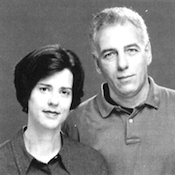Transformations: Awakening to the Sacred in Ourselves
Tracy Cochran and Jeff Zaleski
Bell Tower: New York, 1995.
193 pp., $21.00 (cloth).

One cold night twelve years ago, Tracy Cochran was walking past an empty parking lot in New York City when she got mugged. One man grabbed her around the neck and choked her, while two others stood hunched in their hooded sweatshirts, their eyes “as dead as bashed-out windows.” As she stood there gasping for air, her knees buckling beneath her, she felt a sensation she had experienced before, in a milder form, during meditation: a stream of “dazzling white light” shot out of her head and thirty or forty feet into the sky, melting into a larger light that reassured her. Although it was years before Cochran understood the full significance of her experience, she eventually came to see her mugging as a “transformation,” a shock that awakened her to the sacred that already resides inside each one of us.
Cochran’s description of that event opens Transformations: Awakening to the Sacred in Ourselves, a book co-authored with her husband, Jeff Zaleski. Transformations explores those moments in which one’s psychological armor is stripped away and the sacredness of the world is revealed. The book combines the couple’s personal memories and reflections with selections from other writers, artists, philosophers, and scholars who have experienced similar moments of awakening. For example, in the first chapter alone, Cochran juxtaposes the account of her mugging with the awakenings experienced by Blaise Pascal, Krishnamurti, and William Segal.
How do we experience the sacred in an ordinary life? When do moments occur that transform our ways of seeing and being in the world? What kinds of moments galvanize us to see the real nature of our being? In the eleven chapters alternately authored by Cochran and Zaleski, the two writers explore a range of places and feelings that have served as catalysts for personal awakenings. They describe how people experience transforming moments at sites as various as an on-line computer discussion group, the deathbed of Zaleski’s father, a backyard in Marlboro, New Jersey (famous for invoking visions of Mary), and the New York Buddhist Church. They also explore how emotions such as fear (Cochran’s mugging), amazement (her participation in a Jerrahi Order mosque), and self-disgust (Bill Wilson’s recovery from an alcoholic binge) can serve as catalysts in the alchemy of transformation.
On ECHO, a Manhattan-based on-line community, one of the participants replies to Zaleski’s question about the spiritual ramifications of writing in cyberspace with the observation that “often the tangent roads lead to the most fertile grounds.” And this idle comment illuminates my one reservation about the book. While I applaud �Transformations’”ambitious scope and generous compass, I found myself wishing it had been slightly better synthesized. Its narrative logic is associative rather than analytic. The final chapter, “Transforming Moments,” is a bricolage of remarks from people as diverse as St. Augustine and Ram Dass, remarks cobbled together by their common attention to awakening. By excising remarks about transforming moments in these people’s lives, the authors fail to reveal the larger design of these lives; they give us only the most vivid patch in a life rather than the texture of the whole. Surely the miracle of awakening lies as much in its context as in the moment in which it occurs. This good book could have been made better, had its authors reflected more deeply on the conditions that fostered these transformations and not just on the events themselves.
A few days after Zaleski’s father died, he turned to “an elderly wise woman” for support. She taught Zaleski an exercise she had learned from her spiritual teacher, G. I. Gurdjieff: each day Zaleski was to picture his father and to remember something he had done to make his father suffer. Zaleski undertook this exercise, and reports that it made him feel as alive as he has ever felt. Later in the book, Cochran suggests that readers spend part of each day paying full attention to a quiet activity with the hands: writing a letter, drawing one’s face in the mirror, or making breakfast with great care. Whether paying acute attention to an important family relationship of the past, or opening the heart and mind to a quiet activity in the present, Cochran and Zaleski remind us that attention is at the center of transformation.
Thank you for subscribing to Tricycle! As a nonprofit, we depend on readers like you to keep Buddhist teachings and practices widely available.